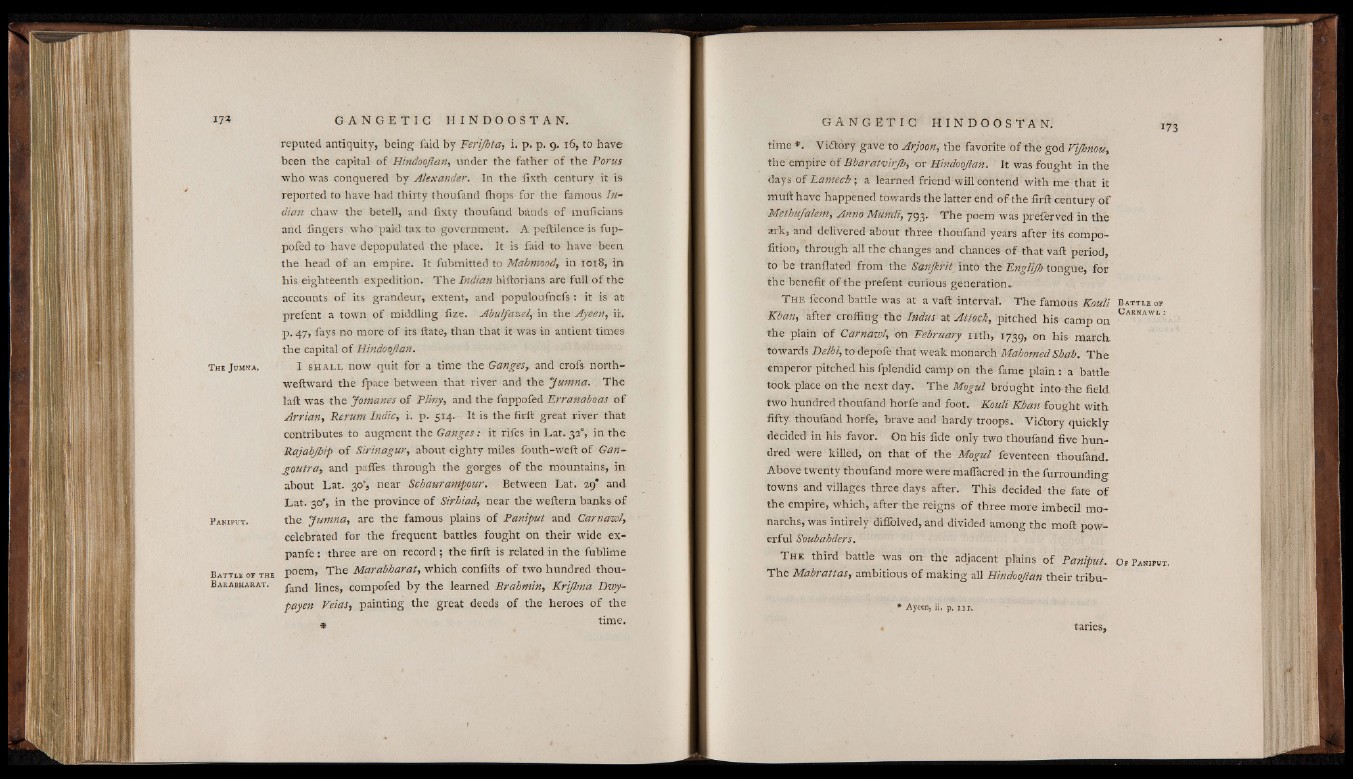
reputed antiquity, being faid by Ferijhta, i. p. p. 9. 16, to have
been the capital of Hindoojlan, under the father of the Porus
who was conquered by Alexander. In the fixth century it is
reported to have had thirty thoufand (hops for the famous Indian
chaw the betell, and iixty thoufand bands of muficians
and fingers who paid tax to government. A pefiilence is fup-
pofed to have depopulated the place. It is faid to have been
the head o f an empire. It fubmitted to Mahmood, in 1018, in
his eighteenth expedition. The Indian hiftorians are full of the
accounts of its grandeur, extent, and populoufnefs: it is at
prefent a town of middling fize. Abulfazel, in the Ayeen, it.
p. 47, fays no more of its ftate, than that it was in antient times
the capital of Hindoeflan.
T h e J u m n a . I s h a l l now quit for a time the Ganges,, and crofs northweftward
the fpace between that river and the Jumna. The
laft was the Jomanes of Pliny, and the fuppofed Erranaboas o f
Arrian, Rerum Indie, i. p. 514. It is the firft great river that
contributes to augment the Ganges: it rifes in Lat. 32“, in the
Rajabjbip of Sirinagur, about eighty miles fbuth-weft of Gan-
_goutra, and paifes through the gorges o f the mountains, in
about Lat. 30°, near Sehaurampour. Between Lat. 29* and
Lat. 30', in the province o f Sirbiad, near the weftern banks of
P an iput. the Jumna, are the famous plains of Paniput and Carnawl,
celebrated for the frequent battles fought on their wide ex-
panfe: three are on record; the firft is related in the fublime
„ noem, The Marabbarat, which confifts of two hundred thou- B a t t l e of th e Jr ~ /
B a r a b h a r a t . f a n ( j ]jneS) compofed by the learned Brahmin, Krijhna Dwy-
payen Veias, painting the great deeds of the heroes o f the
* time,
time *. Vidtory gave to Arjoon, the favorite o f the god Vijhnou,
the empire o f Bbaratvirjb, or Hindoojlan. It was fought in the
days of Lameeh ; a learned friend will contend with me that it
muft have happened towards the latter end o f the firft century o f
Methufalem, Anno Mundi, 793. The poem was preferved in the
ark, and delivered about three thoufand years after its compo-
fition, through all the changes and chances o f that vaft period,
to be tranilated from the Sanjkrit into the Englijb tongue, for
the benefit of the prefent curious generation..
T h e fecond battle was at a vaft interval. The famous Kouli B a t t l e of
Khan, after croffing the Indus at Attock, pitched his camp on Carnawl :
the plain o f Carndwl, on February n th , 1739, on his march
towards Delhi, to depofe that weak monarch Mahomed Shah. The
emperor pitched his fplendid camp on the fame plain : a battle
took place on the next day. The Mogul brought into-the field
two hundred thoufand horfe and foot. Kouli Khan fought with
fifty thoufand horfe, brave and hardy troops. Vicftory quickly-
decided in his favor. On his fide only two thoufand five hundred
were killed, on that o f the Mogul feventeen thoufand.
Above twenty thoufand more were maflacred in the furrounding
towns and villages three days after. This decided the fate o f
the empire, which, after the reigns o f three more imbecil mo-
narchs, was intirely diffolved, and divided among the moft powerful
Soubahders.
T h e third battle was on the adjacent plains o f Paniput. O f Pan ipu t .
The Mabrattas, ambitious of making all Hindoojlan their tribù-
* Ayeen, ii. p, l i i -.